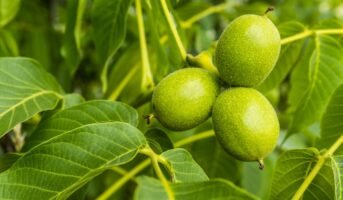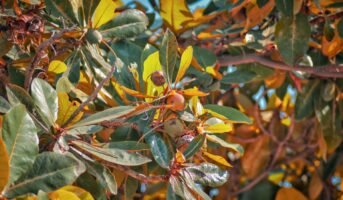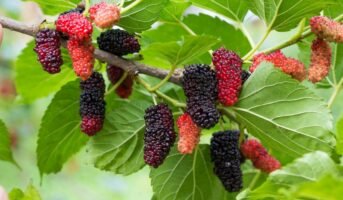Castanea sativa, commonly known as Sweet Chestnut or Spanish Chestnut, is a deciduous tree native to temperate regions like Southern Asia and Europe. For thousands of years, it has been cultivated because of its seeds, the nuts, which are not only edible but also an essential cooking ingredient.
It is also used as a substitute for potatoes and flour in different regions. The Chestnuts are believed to have twice the amount of starch in potatoes and a considerable amount of carbohydrates, which is helpful in making sweet dishes and desserts.
See also: Fig Plant or Ficus Carica: Facts, types, maintenance and uses
Chestnut tree: Quick facts
| Name of plant species | Castanea sativa |
| Common name | Chestnut Tree/Sweet Chestnut |
| Height | American varieties – Over 80’
European varieties – 65’ Chinese varieties – 40’ |
| Family name | Fagaceae |
| Distribution range | Temperate regions of the world – Southern Europe, Asia, America |
| Uses | The American variety contains tannin, useful for cold and cough, breathing issues, arthritis, and also works as an effective sedative. The European and Asian varieties offer high-quality wood for multiple purposes and also produce edible seeds and fruits. |
| Best season to grow | For colder regions – Early Spring
For warmer regions – Early Fall/Autumn |
| Care and maintenance |
|
| Environmental Impact | As they are fast growers, Chestnut trees help reduce greenhouse gases from the environment in large amounts. |
Chestnut tree: Physical description
The different varieties of the Chestnut tree can be identified by certain characteristics that are unique to them as follows:
American Chestnut – These are 18-30 metres in height with reddish or Chestnut brown twigs and bullet-shaped brown buds. The mature leaves are hairless, thin as paper and light green in colour, drooping from the twigs, while the burs with up to 3 nuts hang at the end of the branch.
European Chestnut – These are tall and straight, like the American variety, but the leaves are hairy and straight, unlike its American counterpart. The twigs are thicker and coarser but become smoother when they mature. The nuts are almost the same size as an American Chestnut, and each bur bears 2-3 of them.
Chinese Chestnut – These are more tolerant and resistant than the other varieties. They can be easily identified by their more oval-shaped, thicker and leathery leaves that rarely have hair on the upper surface. The buds are dull-brown to black, and the nuts are 1.87-5 cm in diameter.
Chestnut tree: How to grow it at home?

Source: Pinterest
First, you must choose the variety you want to grow at home. You will need a considerable space in your backyard to grow the tree, which attains a height of a minimum of 40 feet.
While the American variety is the tallest and produces the sweetest nuts, European varieties are more resistant with a lesser height than its American peers. The Chinese varieties are the shortest but produce the largest seeds. Select the one you want to cultivate, depending on your preferences.
Growing Chestnut trees with seeds and saplings
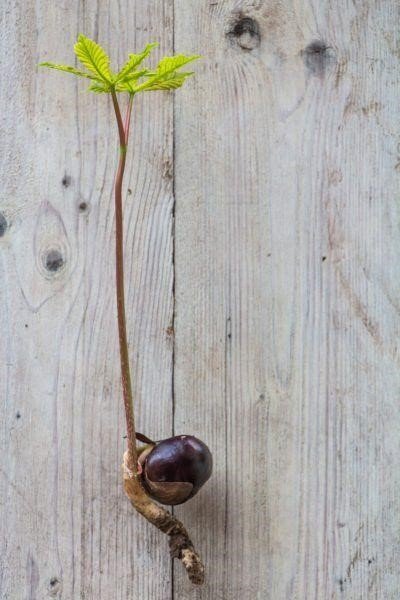
Source: Pinterest
According to gardening experts, cultivating the Chestnut tree from seeds is easier and less labour-intensive. However, planting a sapling reduces the harvesting time and improves the plant’s disease-resisting capacities. If you live in a tropical area, plant the seeds/saplings in early fall/autumn, so the plant is ready to pop up in spring.
Soil requirements for growing Chestnut tree
Understanding the soil requirements of a Chestnut tree is the most crucial consideration in its cultivation. All varieties require well-draining soil, preferably sandy or loamy. They can also thrive well in clayey soils if there is a slope.
One more thing to note here is that the tree requires acidic soil to grow, so get a pH test done before sowing the seeds. A pH of 4.5 to 6.5 is considered best to grow Chestnut trees.
Watering requirement for growing Chestnut tree
You need to water the young plant regularly throughout its growing season. It will help the tree produce larger, fuller-sized nuts after 3 years. Make sure that the plant gets an inch of water at the root zone every week. As the soil is fast-draining, you may need to water the plant 2-3 times a week. The soil should be moist at all times but not soggy. If you are living in a warmer region, placing mulch around the roots can help reduce watering requirements and ease your pressure to some extent.
Fertilisation requirements for growing Chestnut tree
To grow a Chestnut tree, you need a mixture of all essential nutrients. An all-purpose, balanced fertiliser is deemed best for its growth. You may also add well-rotted compost around the root area for added benefits. Adding some mulch will also help retain moisture and encourage helpful living creatures, like earthworms, some fungal growth that benefits the plant, making it harder, sturdier and more resistant to diseases.
Note: When the tree starts showing one foot of healthy growth annually, know that it does not require any more fertilising.
Growing Chestnut trees in pots
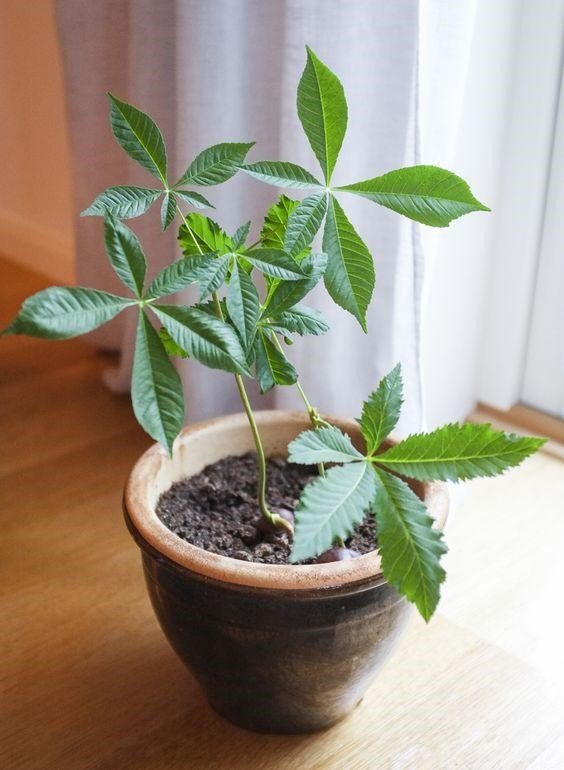
Source: Pinterest
Horse Chestnuts can be grown in pots for a few years before planting them in the ground. However, you can turn them into bonsais and continue to grow in pots. Here is how:
- Horse Chestnut trees love the chills, so you need to keep them in a cooler place to release the embryos from dormancy.
- Cover the container with plastic or glass to retain moisture and mist whenever it feels dry.
- As the plant starts growing leaves, move it to a larger container and place it in a sheltered location, away from direct sunlight. After a year, you can either plant it on the ground or start training it as a bonsai.
- Prune the roots regularly and nip extra leaves, keeping only about three pairs of sprouts.
- In the following year, place the plant in a new container and prune the taproot (about two-thirds of the entire system).
- After 3-4 years, the tree will develop an interesting bonsai form that you can keep in containers for its aesthetic value.
- The only work you have is to keep repotting the plant every few years to keep it healthy and growing.
After some years, you will see that the plant has become accustomed to its new form and then you will no longer need to prune the roots or leaves and let it be.
Chestnut tree: Care tips
Cutting back and pruning are the two main maintenance criteria the Chestnut tree adheres to. Pick a dry day in winter to start with the pruning job. Use a pruner to cut back branches less than one inch in diameter. Use loppers for branches that are 1 to 2.5 inches and saws for those bigger.
Pruning of diseased branches, however, should be completed in winter. But make sure that you do not prune the tree during the monsoons, as it may make it easier for diseases and pests to invade the pruning wounds.
Chestnut tree: Benefits
The first thing that comes to mind when discussing the benefits of Chestnut trees is their edible seeds. The Chestnuts are mildly sweet, versatile seeds that can be incorporated into several dishes, like salads and soups and also to develop delicious treats during Christmas and other festivities.
The nuts contain valuable nutrients, like proteins, carbs, fibre, copper, manganese, helpful fat, vitamins B6 and C, folates, riboflavin and potassium. They also contain other nutrients, like vitamins B5, B3 and K. Still, the most beneficial thing is that they are lower in fat than other nuts and packed with proteins and good calories, which is why they are preferred for fitness over other nuts.
These are also loaded with antioxidants, like tannins, alkaloids, polyphenols, zeaxanthins, etc., which protect your organs and systems against free radicals. The Chestnuts are also said to improve cardiovascular health and help control blood sugar for diabetics and non-diabetics. The nuts have anti-inflammatory properties and are essential to your weight loss regime.
Chestnut tree: Toxicity
The Horse Chestnut is considered toxic and should not be consumed. It contains Sapolin Aesculin, a toxin that makes all parts of the plant highly poisonous. Besides stomach irrigation, it has been reported that children who accidentally consume horse Chestnut seeds experience muscle twitching, mobility issues and even paralysis.
The Chestnut Tree: Symbol of Longevity and Strength


Chestnut Trees: The Majestic Giants of the Forest

The Nutty Goodness of Chestnut Trees

FAQs
How large should the container be for a young Chestnut tree?
You will need a container that is at least 10” deep for a young American Chestnut tree. If you do not get such deep containers in the market, you can use a milk or juice carton, as these tend to be quite deep. The rule of thumb is the container should be deeper than it is wide.
What kind of soil should we use to grow a Chestnut tree in a container?
You need well-draining, sandy/loamy soil that is acidic. A pH of 4.5-6.5 is best for Chestnut trees.
How to plant a Chestnut to grow it into a tree?
The nuts require at least 2-3 months of cold before they can be planted for growth. You can use cold storage to keep the seeds before planting them in a container or the ground. If you are planting the seeds in a greenhouse, keep in mind that you should place them near a sunny window sill with a temperature of 70-80 F.
When to harvest a Chestnut tree?
You will see that the nuts will fall on the ground when they are mature enough to be harvested. Do not knock them from the tree and let them fall off by themselves. You can collect mature nuts from the ground.
Can I eat the nuts raw?
It is considered unwise to eat the nuts raw, as it can lead to health hazards in some people. However, the nuts are completely edible once cooked.
Housing News Desk is the news desk of leading online real estate portal, Housing.com. Housing News Desk focuses on a variety of topics such as real estate laws, taxes, current news, property trends, home loans, rentals, décor, green homes, home improvement, etc. The main objective of the news desk, is to cover the real estate sector from the perspective of providing information that is useful to the end-user.
Facebook: https://www.facebook.com/housing.com/
Twitter: https://twitter.com/Housing
Email: [email protected]

